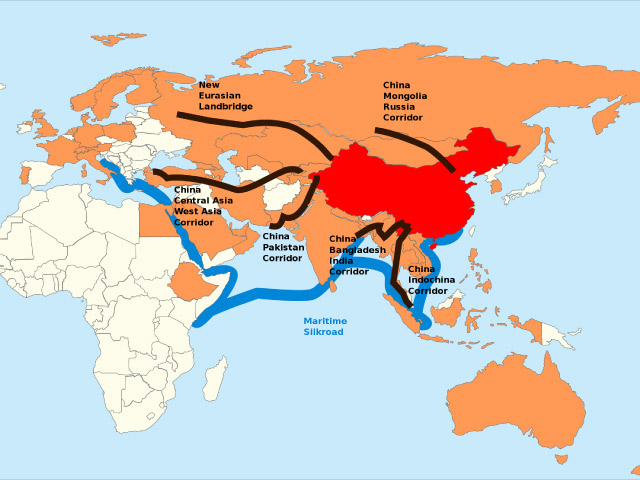History
The Belt and Road Initiative is known by different names:
- The New Silk Road
- Silk Road Economic Belt
- The BIS
- The belt and the road
- OBOR (One Belt, One Road)
- China's Economic Model - The Silk Road
- How has the Belt and Road Initiative played a part in China's cross-regional political and security relations?
All these names for a single definition: Set of maritime and rail connections between China and Europe and passing through different countries:
- Russia
- Belarus
- Kazakhstan
- Poland
- Germany
- England
- France
This New Silk Road was unveiled in 2013 by the government of President Xi Jinping. The latter talks about it in his speech at the University of Kazakhstan.
The project was formalised in the texts in March 2015. From an idea, we arrive at a reference project for globalisation and proof that China can see in the long term and on a global scale.
In 2016, India and Japan launched the "Asia-Africa Growth Corridor" in parallel, aimed at discrediting the Chinese project by creating maritime channels that were more affordable and focused on sustainable development.
Initially, only a few countries were involved. From around sixty at the start, there are more than a hundred in 2017.
In order to establish its decision, in October 2017, the BRI was included in the Constitution of the Chinese Communist Party during the National Congress.
The sectors concerned are also more numerous with, among others, tourism, telecommunications, and energy.
In 2019, the United States stepped up to the plate, criticising Italy's participation to China's project, considering that the latter was a "disguised call for investment". In cooperation with Japan and Australia, they create the Blue Dot Network, an alternative to the Silk Road economic belt.
In 2020, the COVID-19 pandemic had terrible socio-economic consequences: a stock market crash and a global economic crisis.
On April 15 of the same year, the Pakistani foreign affairs president asked his Chinese counterpart for global debt relief in order to meet the future investments that Pakistan would have to make.
Subsequently, several countries, mostly African, expressed their difficulties in repaying the loans committed to China for the construction of infrastructure related to the project.
All these setbacks call into question the legitimacy and feasibility of the project. For example, the railway project linking China to Malaysia and the high-speed line project in Thailand had to be put aside.
Corridors of the BRI
Land corridors
There are 6 of them as of now :
- New Economic Corridor of the Eurasian Land Bridge
- China Corridor – Mongolia – Russia
- China Corridor – Indochinese Peninsula
- China Corridor – Central Asia – Western Asia
- Bangladesh Corridor – China – India – Myanmar
- China – Pakistan Corridor
Maritime corridors
The maritime route connects China to Indonesia, Southeast Asia, India, the Arabian Peninsula, Egypt, Somalia finally, Europe.
Issues and guidelines
The project is often compared to the American Marshall Plan which aimed to lend to countries heavily affected by the Second World War in order to help them rebuild their infrastructures, on the condition that these same countries import the necessary equipment whose value equals that of the loans.
The New Silk Road, due to its global importance, risks leading to over-indebtedness of the countries concerned in the, more or less, long term, given the ups and downs of the economy since the COVID crisis.
For China, it is a way to further extend its economic and geopolitical influence and thus be taken as a model by the rest of the world.
It is also a strategy for stabilising its growth in the absence of a rapid increase.
For partner countries, it is a solution to strengthen their infrastructure and increase their growth prospects.
The other side of the coin is a risk of an increase in their debt which as a result, could significantly slow down these same growth prospects.
Pillars of the BRI
The BRI is based on 5 pillars:
- Intergovernmental exchanges and top-down communication on macroeconomic policy
- Revision and improvement of infrastructure construction plans and standards
- Facilitate investment and trade
- Foster dialogue and media cooperation
- Creation of a financing establishment for political and monetary homogeneity (political banks, public banks, financial institutions, etc.)
Institutions involved
Regarding the financing of this ambitious $8 trillion project, various institutional mechanisms are being put in place:
- Public banks
- Political banks
- International financial institutions
- State funds
Two new institutions were created:
- China development bank
- The Asian infrastructure investment bank was created with the help of some twenty Asian countries, headquartered in Beijing. Its capital is estimated at around 100 billion US dollars.
Different financing channels such as private equity investment, BRI bonds, and both public and private partnerships will be solicited. Companies will also have to invest.
China has long understood that having control of the maritime network would be a major asset for it as it was in the days of the old Western trading posts. It is for this reason that Azerbaijan has embarked on the titanic construction of a new terminal for ferries and freighters in Alat, thus enabling it to handle 3.5 times more freight.
This road could make it possible to connect Asia to Europe. Passing, in particular, through Kyrgyzstan, Tajikistan, Iran, and Turkey.
Two other routes could facilitate access to the European continent; one that would pass through Kazakhstan and Russia and another through the Caspian Sea.
In 2009, China inaugurated a gas pipeline in Central Asia. In 2013, the latter transported just over 30% of China's consumption.
In 2013, a train departed from the Zhengzhou region and reached Hamburg.
In 2014, a train connected Yiwu to Madrid, which is about 13000 kilometres.
Since then, several rail links have been established, linking Asia to the rest of Europe.









